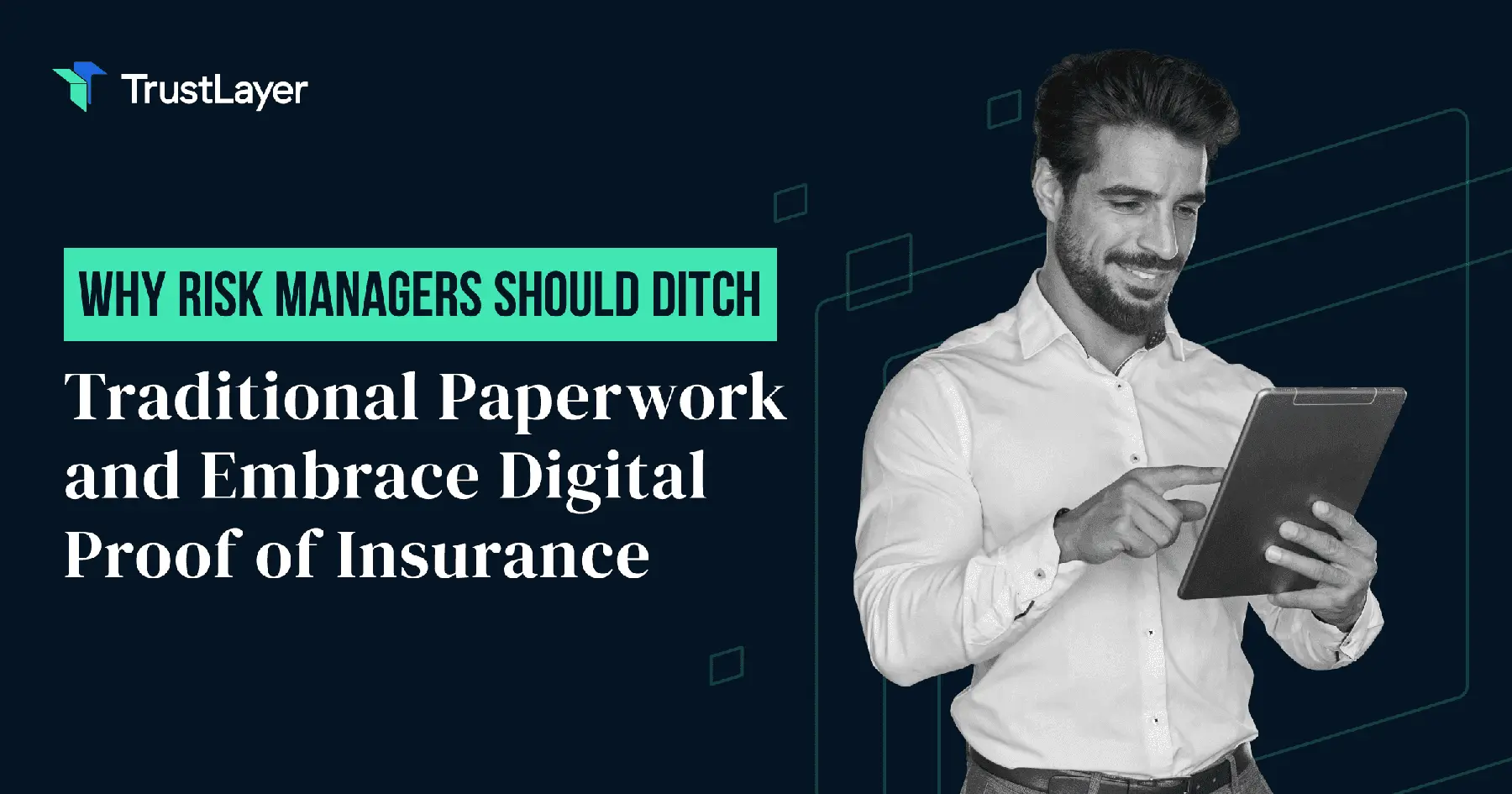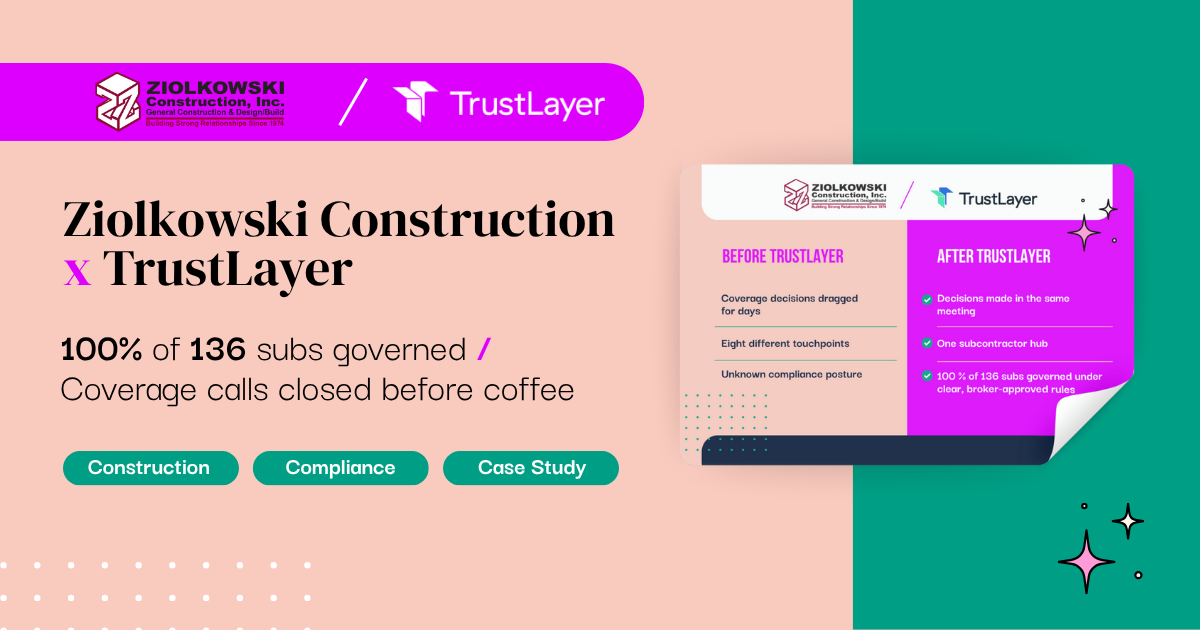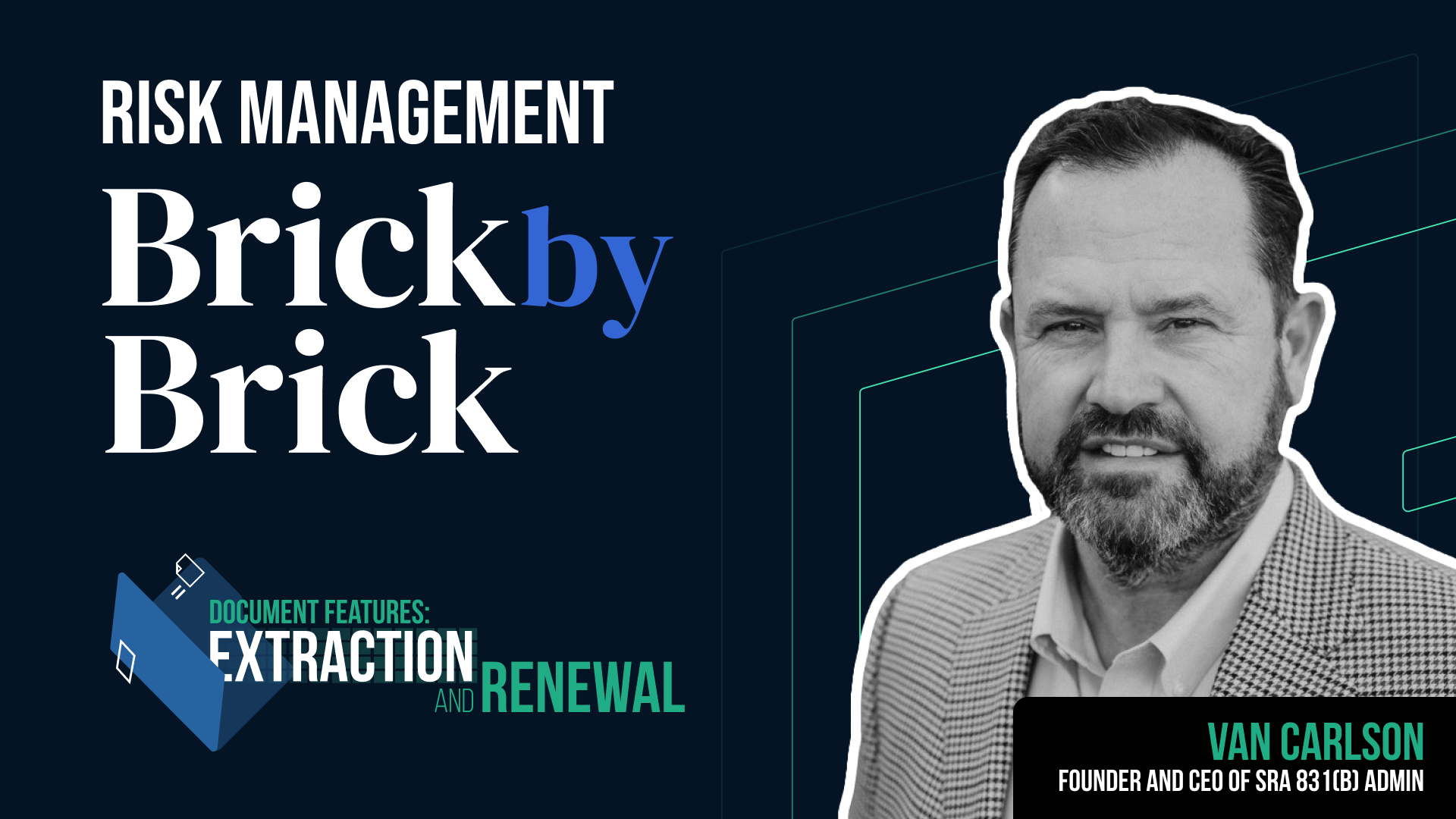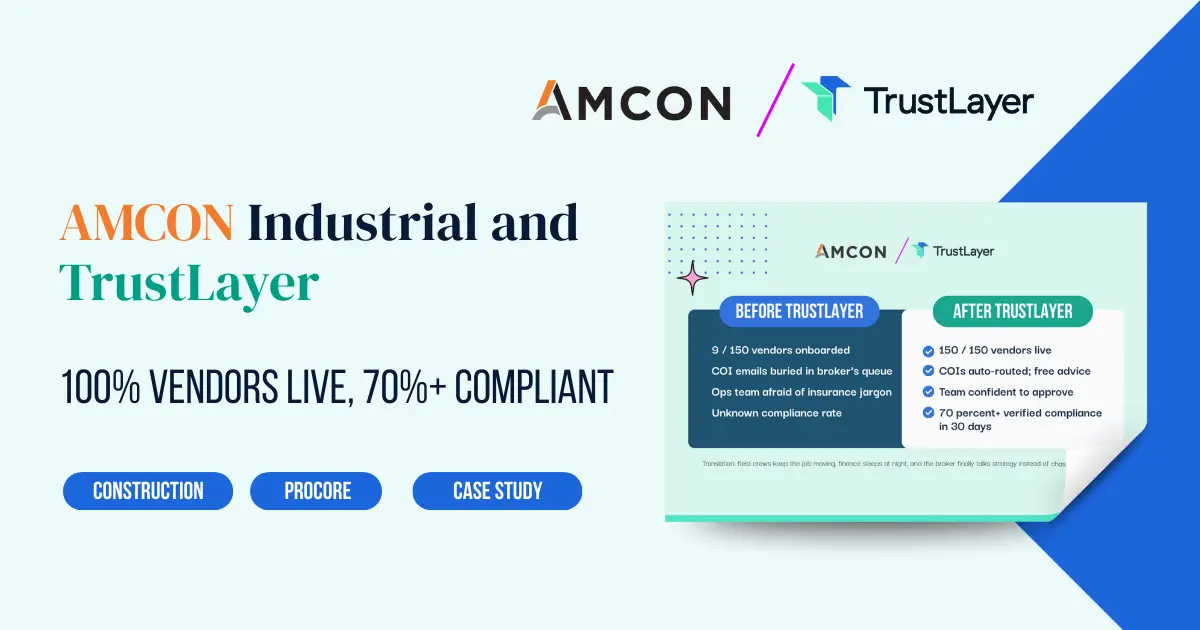 Resources
Resources Why Risk Managers Should Ditch Traditional Paperwork and Embrace Digital Proof of Insurance
Why Risk Managers Should Ditch Traditional Paperwork and Embrace Digital Proof of InsuranceWhy Risk Managers Should Ditch Traditional Paperwork and Embrace Digital Proof of Insurance

In today's fast-paced digital world, it's time for risk managers to bid farewell to the hassles of traditional paperwork and embrace the efficiency and convenience of digital proof of insurance. With technology constantly evolving, there's no reason to cling to outdated processes that consume time, resources, and carry the risk of errors and misplacement.
Understanding the Role of Risk Managers
Before we delve into why risk managers should make the shift towards digitalization, let's take a moment to understand the vital role they play within organizations. Risk managers are responsible for identifying, assessing, and mitigating potential risks that can adversely impact a company's operations, reputation, and financial stability. Their job is to implement strategies and protocols to avoid or reduce risks, ensuring the overall protection of the organization.
In their quest to safeguard businesses, risk managers have traditionally relied on a plethora of paperwork and manual processes to manage insurance documentation. However, this traditional approach is increasingly proving to be outdated and ineffective.
The Traditional Approach to Risk Management
Historically, risk managers have relied on paper certificates of insurance to verify coverage and ensure contractual compliance. This manual approach involved physically handling and storing documents, leading to potential issues of misplacement, damage, or loss.
Furthermore, the time-consuming nature of paper-based processes often impeded efficiency and productivity, diverting valuable resources away from other critical tasks. The endless cycle of requesting, reviewing, and processing paper certificates became a cumbersome and redundant operation that hindered streamlined risk management.
Amidst these challenges, risk managers faced the daunting task of maintaining an organized and up-to-date repository of insurance documentation. The constant need to manually update records and track policy renewals added to the administrative burden, leaving little time for proactive risk assessment and strategic planning.
The Shift Towards Digitalization in Risk Management
With the advent of technology, the landscape of risk management is rapidly evolving. Forward-thinking risk managers are embracing digital solutions that allow for more efficient and effective risk mitigation strategies.
Digital proof of insurance is revolutionizing how risk managers operate by providing a secure, accessible, and user-friendly platform for managing insurance documentation. By transitioning from paper to digital, risk managers can streamline their workflows and optimize their risk management processes.
One of the key advantages of digitalization is the ease of access to insurance information. With a digital platform, risk managers can quickly retrieve and review policy details, coverage limits, and endorsements, eliminating the need to search through stacks of paper documents. This instant access to critical information enables risk managers to make informed decisions and respond promptly to emerging risks.
Moreover, digitalization enhances collaboration and communication within the organization. Risk managers can easily share insurance documentation with relevant stakeholders, such as legal teams or senior management, facilitating a more streamlined and transparent risk management process. Real-time updates and notifications ensure that all parties are on the same page, reducing the chances of miscommunication or missed deadlines.
Another significant advantage of digitalization is the ability to automate routine tasks. Digital platforms can automatically track policy renewals, send reminders, and generate reports, freeing up valuable time for risk managers to focus on strategic risk assessment and proactive risk mitigation. This automation not only improves efficiency but also reduces the risk of human error that can occur during manual data entry or processing.
Furthermore, digital platforms offer robust security measures to protect sensitive insurance information. Encryption, access controls, and audit trails ensure that only authorized individuals can view or modify insurance documentation, safeguarding against data breaches or unauthorized access. This heightened security provides risk managers with peace of mind, knowing that their organization's insurance information is well-protected.
As the digital landscape continues to evolve, risk managers must adapt and embrace digitalization to stay ahead in an increasingly complex and interconnected business environment. The advantages of transitioning to a digital approach are undeniable, offering risk managers the tools they need to effectively navigate the ever-changing landscape of risk management.
The Drawbacks of Paper-Based Insurance Proof
While paper certificates of insurance have served as the industry standard for a long time, it's time to acknowledge their limitations and seek better alternatives. Here are the key drawbacks of relying on paper-based insurance proof:
Time and Resource Consumption
Managing stacks of paper certificates can be a time-consuming and resource-draining endeavor, diverting valuable energy and manpower from more strategic risk management tasks. In a world where time is of the essence, it's imperative for risk managers to find more efficient ways to handle their insurance documentation.
Consider the amount of time it takes to manually file and organize paper certificates. Each certificate must be carefully sorted, labeled, and stored in a physical filing cabinet. This process not only requires significant manpower but also takes up valuable office space.
Furthermore, retrieving specific certificates from a large collection can be a daunting task. Risk managers may spend hours searching through stacks of paper, increasing the likelihood of errors and delays.
Risk of Errors and Misplacement
Manually handling and storing paper certificates increases the risk of errors, misplacement, or loss. Mistakes in documentation can lead to compliance issues, unexpected liabilities, and unnecessary financial losses. Additionally, the misplacement or loss of physical documents can have dire consequences when proof of insurance is needed urgently.
Consider the scenario where a business is audited and required to provide proof of insurance coverage for a specific period. If the paper certificate for that period is misplaced or lost, the business may face severe penalties or even legal consequences. The risk of misplacing or losing a paper certificate is significantly higher compared to digital alternatives.
Moreover, errors in manual data entry can occur when transcribing information from paper certificates into digital systems. These errors can lead to discrepancies in coverage details, potentially resulting in denied claims or inadequate protection.
By relying on paper-based insurance proof, businesses are exposing themselves to unnecessary risks and inefficiencies. It's time to embrace technological advancements that offer more secure, accurate, and streamlined methods of managing insurance documentation.
The Advantages of Digital Proof of Insurance
Now that we understand the drawbacks of paper-based insurance proof, let's explore the advantages of embracing digital proof of insurance:
As technology continues to advance, the insurance industry is also evolving to keep up with the changing times. One significant development in recent years is the shift towards digital proof of insurance. This innovative approach offers numerous benefits that can revolutionize the way insurance is managed and accessed.
Enhanced Efficiency and Accuracy
By making the switch to digital proof of insurance, risk managers can streamline their processes and reduce the time spent on paperwork. Gone are the days of sifting through stacks of paper documents and manually verifying coverage. Digital platforms offer automated workflows, allowing for quick and efficient verification of coverage and compliance.
With just a few clicks, risk managers can access comprehensive insurance information, including policy details, coverage limits, and renewal dates. This automation significantly reduces the risk of errors, ensuring accurate and up-to-date insurance documentation. By eliminating manual data entry, the chances of typos and other mistakes are greatly minimized, providing peace of mind for both insurers and policyholders.
Furthermore, digital proof of insurance allows for seamless integration with other systems and processes. This integration enables real-time updates and synchronization of data across multiple platforms, ensuring that all stakeholders have access to the most current and accurate information.
Improved Accessibility and Convenience
Going digital means embracing the convenience of instant access to insurance documentation anytime, anywhere. No longer do risk managers have to rely on physical copies or wait for documents to be mailed or faxed. Digital platforms provide centralized storage of insurance certificates, making it easy for risk managers to retrieve and share documents promptly.
Whether in the office, on the go, or working remotely, risk managers can access their digital proof of insurance with just a few clicks. This enhanced accessibility fosters collaboration and ensures that stakeholders have the necessary information at their fingertips. In addition, digital proof of insurance can be easily shared with clients, partners, and regulatory authorities, eliminating the need for physical copies and reducing the risk of lost or misplaced documents.
Moreover, digital proof of insurance offers the convenience of electronic signatures. Instead of printing, signing, and scanning documents, risk managers can electronically sign insurance certificates, saving time and resources. This digital signature is legally binding and provides the same level of authenticity and security as a physical signature.
Another advantage of digital proof of insurance is the ability to store and organize documents in a structured manner. Digital platforms often offer advanced search and categorization features, allowing risk managers to quickly locate specific insurance certificates or filter documents based on various criteria. This organizational efficiency enhances productivity and reduces the time spent searching for information.
In conclusion, digital proof of insurance offers enhanced efficiency, accuracy, accessibility, and convenience. By embracing this digital transformation, risk managers can streamline their processes, reduce paperwork, and ensure that insurance documentation is always up-to-date and easily accessible. As technology continues to advance, it is crucial for the insurance industry to adapt and leverage digital solutions to meet the evolving needs of insurers, policyholders, and other stakeholders.
Transitioning from Paper to Digital: A Step-by-Step Guide
Now that the advantages of digital proof of insurance are clear, let's discuss the practical steps risk managers can take to transition from paper to digital:
Evaluating Current Processes
The first step in transitioning to digital proof of insurance is to assess your current processes and determine the pain points and areas for improvement. This evaluation involves a thorough examination of your organization's paperwork workflow, from the initial request for insurance proof to the final verification process.
During this evaluation, it is essential to identify the bottlenecks in your paperwork workflow. These bottlenecks may include manual data entry, lengthy approval processes, or difficulties in tracking and storing physical documents. By pinpointing these specific pain points, you can better understand the challenges that need to be addressed in the transition to digital.
Additionally, it is crucial to consider the specific needs and requirements of your organization. Different industries and organizations may have unique compliance regulations or internal policies that must be taken into account when implementing a digital solution. By understanding these needs, you can ensure that the chosen digital solution aligns with your organization's goals and objectives.
Implementing Digital Solutions
Once you have evaluated your needs, it's time to consider implementing a digital solution that fits your organization's requirements. TrustLayer, a leading provider of digital proof of insurance, offers a comprehensive platform that addresses the challenges faced by risk managers.
TrustLayer's platform streamlines the verification process by automating many of the manual tasks involved in paperwork. With features such as automated data entry, real-time verification, and secure document storage, TrustLayer's solution minimizes errors and reduces the time and effort required for insurance proof verification.
Furthermore, TrustLayer's platform ensures regulatory compliance by integrating with industry-standard databases and continuously updating information to reflect any changes in insurance coverage. This integration eliminates the need for manual checks and reduces the risk of using outdated or invalid insurance proof.
By leveraging TrustLayer's platform, risk managers can enjoy a seamless transition to digital proof of insurance. The platform's user-friendly interface and intuitive design make it easy for employees to adapt to the new digital workflow. This empowers risk managers to focus on strategic risk management rather than drowning in paperwork, ultimately improving overall efficiency and productivity within the organization.
In conclusion, transitioning from paper to digital proof of insurance involves a careful evaluation of current processes and the implementation of a digital solution that meets the specific needs of the organization. TrustLayer's platform offers a comprehensive solution that streamlines the verification process, minimizes errors, and ensures regulatory compliance. By embracing digital proof of insurance, risk managers can enhance their risk management practices and free up valuable time and resources for more strategic initiatives.
Overcoming Challenges in the Digital Transition
While the benefits of going digital are numerous, it's essential to address potential challenges that may arise during the transition:
Addressing Security Concerns
As risk managers deal with sensitive insurance documentation, it's natural to have concerns about the security of digital platforms. When choosing a digital solution, ensure that it adheres to industry-standard security protocols and offers robust encryption to protect data integrity.
TrustLayer, for example, employs advanced security measures to safeguard confidential information, providing risk managers with peace of mind while embracing digital proof of insurance.
Ensuring Regulatory Compliance
Regulatory compliance is a top priority for risk managers, and the transition to digital proof of insurance should not compromise this aspect. Choose a digital solution that meets regulatory requirements and offers seamless integration with existing systems and processes.
TrustLayer ensures regulatory compliance, allowing risk managers to maintain a high level of confidence in their insurance documentation while reaping the benefits of a digital platform.
In conclusion, risk managers must bid farewell to the constraints of traditional paperwork and embrace the efficiency and convenience of digital proof of insurance. By making this transition, risk managers can enhance efficiency, improve accuracy, and streamline their workflows. TrustLayer's comprehensive platform provides the ideal solution, combining security, regulatory compliance, and user-friendly features to empower risk managers to focus on what matters most - protecting their organizations from potential risks.









.png)



